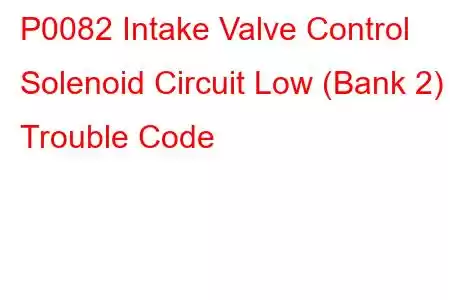P0082 Intake Valve Control Solenoid Circuit Low B2
OBD-II Trouble Code Technical Description
Intake Valve Control Solenoid Circuit Low (Bank 2)
What does that mean?
This code is a generic OBD-II powertrain code, that means it applies to all makes and models of vehicles (1996-newer), although specific repair steps may vary depending on the model.
On vehicles equipped with variable valve timing (VVT), the Engine Control Module / Powertrain Control Module (ECM/PCM) controls the camshaft position by regulating the engine oil through the control solenoid to change the position of the camshaft. The control solenoid is commanded using a Pulse Width Modulated signal (PWM) from the ECM/PCM. The ECM/PCM monitors this signal and if the voltage is below specification, it will set this trouble code and illuminate the Malfunction Indicator Lamp (MIL).
Bank 2 refers to the side of the engine that does not contain cylinder #1 - be sure to verify according to manufacturers specifications. The intake valve control solenoid is usually located on the intake manifold side of the cylinder head. This code is similar to codes P0081 and P0083. This code may also be accompanied by P0028.
Symptoms
Symptoms may include:
Check engine light illuminated (Malfunction indicator lamp) Vehicle may suffer from poor acceleration and decreased fuel economy.Potential Causes
Potential causes of a P0082 diagnostic trouble code may include:
Wire harness shorted to ground Solenoid shorted to ground Faulty ECMDiagnostic Steps
Wire harness - Unplug harness connectors from the PCM/ECM, using a wiring diagram locate the + and - wires to the solenoid. The solenoid can be ground side or power side controlled, depending on the application. Check with factory wiring diagrams to determine the power flow in the circuit. Using a digital volt ohm meter (DVOM) set to the volts setting, check for voltage with the positive lead on the vehicle battery and the negative lead on each wire to the control solenoid. Depending on the application, if the solenoid is grounded to chassis, test the power lead to the control solenoid at the PCM/ECM wiring harness, there should be no voltage present. If there is voltage present, check for a short to ground in the wiring up to the control solenoid by unplugging connectors and working back to the solenoid.
Control solenoid - Check for a short to ground through the control solenoid by putting either DVOM lead to a known good ground and the other to each terminal on the control solenoid. If there is a low resistance present, the solenoid may be shorted internally.
PCM/ECM - If all wiring and the control solenoid checks out okay, it will be necessary to monitor the solenoid during engine operation by back probing the wires at the PCM/ECM. Using an advanced scan tool that will read the engine functions, monitor the duty cycle commanded to the control solenoid. It will be necessary to monitor the solenoid during engine operation under various engine RPM's and load. Using an oscilloscope or graphing multimeter set to the duty cycle scale, connect the negative lead to a known good ground and the positive lead to either wire terminal at the solenoid itself. The reading on the multimeter tool should match the commanded duty cycle on the scan tool. If they are opposite, the polarity may be reversed - connect the positive lead on the other wire terminal to the solenoid and re-test to verify. If there is no signal detected from the PCM, there may be a fault with the PCM itself.
Read: 54


